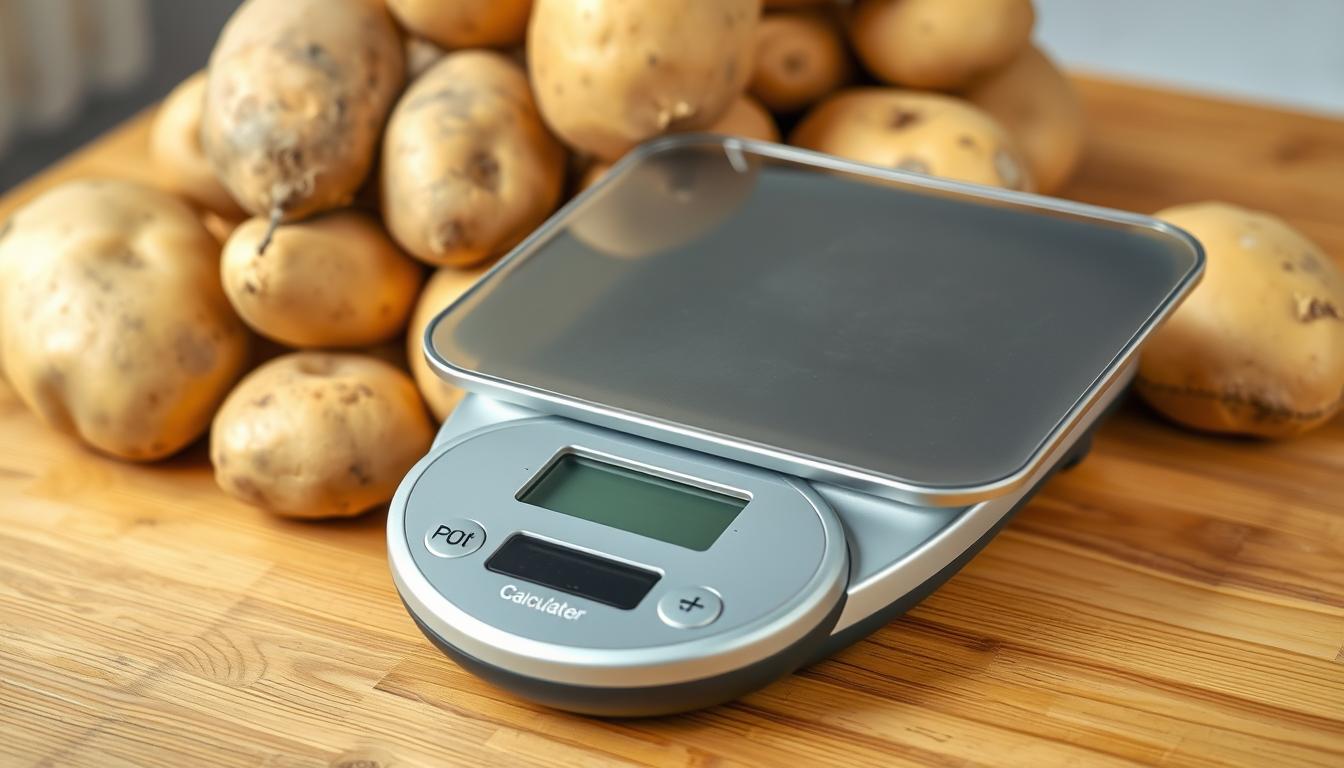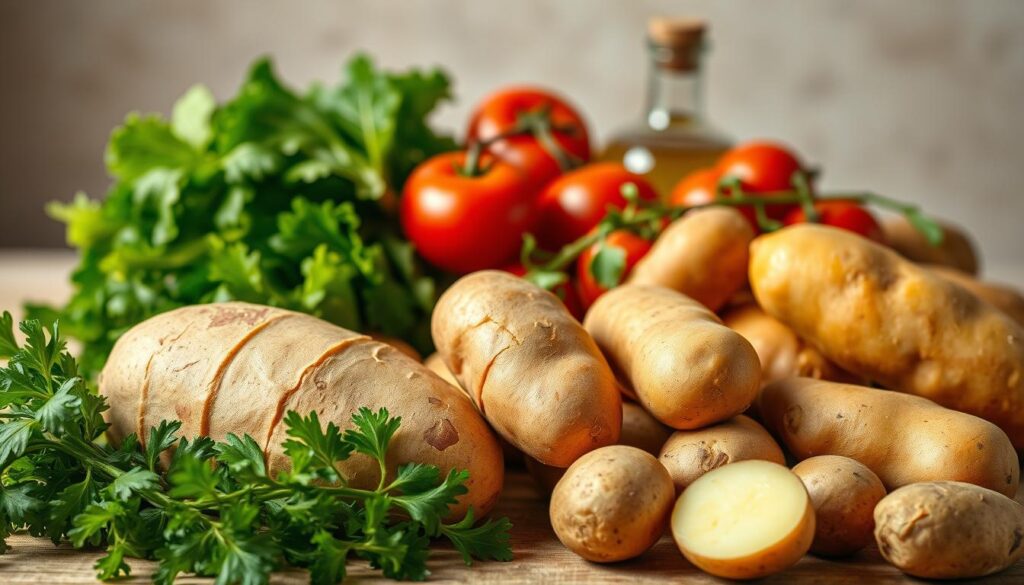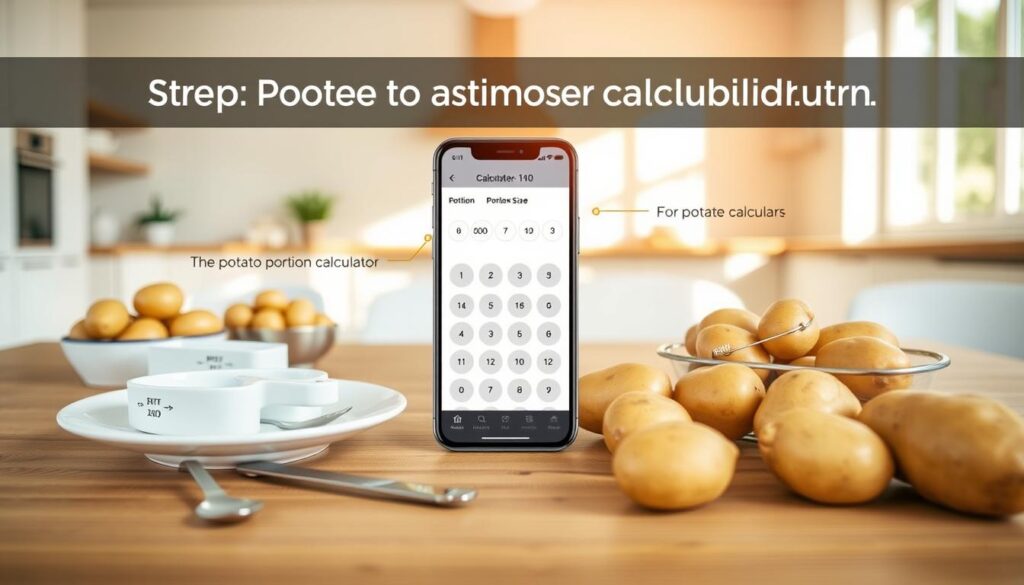When planning meals, many assume starchy vegetables like potatoes don’t belong in health-conscious routines. But what if we told you they’re essential for creating satisfying, nutrient-rich plates? The secret lies in precise portion control – and that’s where our weight calculator for potato-based diets becomes your kitchen ally.
Understanding serving sizes transforms how you approach recipes. One cup of mashed potatoes might weigh differently than roasted wedges, affecting your calorie intake and nutritional balance. Our tool simplifies these conversions, whether you’re tracking grams, ounces, or cups.
Why does accuracy matter? Overestimating portions can lead to wasted ingredients or imbalanced meals. By calculating water ratios and ingredient quantities, you’ll craft dishes that align with personal goals – from weight management to muscle gain. This resource also helps adjust recipes for groups, ensuring everyone gets their fill without excess.
Key Takeaways
- Portion precision enhances nutritional outcomes in spud-focused meals
- Standardized measurements (cups/grams) prevent recipe inconsistencies
- Water-to-potato ratios significantly affect meal textures and volumes
- Adaptable calculations work for solo dinners or family gatherings
- Regular tool use builds better intuition for ingredient proportions
We’ve designed this guide to help you master potato prep through data-driven decisions. You’ll discover how small measurement tweaks create big differences in your culinary results – and why our weight calculator for potato-based diets belongs in every health-savvy cook’s toolkit.
Understanding Our Potato-Based Diet and Weight Essentials
Balanced nutrition often overlooks the humble spud, yet its versatility forms meal foundations. Our approach celebrates potatoes as nutritional powerhouses when paired with colorful vegetables. This combination delivers essential vitamins, fiber, and sustained energy – key for maintaining wellness goals.
The Science Behind Starchy Staples
One medium potato provides 25% of daily vitamin C needs. When roasted with olive oil and herbs, it becomes a flavor-packed base for meals. Leafy greens or roasted carrots add texture and nutrients, creating plates that satisfy taste buds and dietary requirements.
Mastering Measurement Fundamentals
Consistent portions prevent overeating while ensuring adequate fuel. Use this table to convert between common units:
| Preparation | Cups | Ounces | Grams |
|---|---|---|---|
| Mashed | 1 | 7.5 | 213 |
| Diced | 1.25 | 6 | 170 |
| Baked | 0.75 | 8 | 227 |
For family meals, multiply single portions by the number of people. Add 10-15% extra when including vegetables like broccoli or peppers. Always account for water content – boiled spuds weigh 20% more than raw ones due to absorption.
These strategies transform guesswork into precise planning. You’ll create meals that nourish without excess, proving smart measurement enhances both health and enjoyment.
Using the Weight calculator for potato-based diets: A Step-by-Step Guide
Mastering meal prep starts with precise measurements. Our digital tool simplifies portion planning while accommodating various cooking methods and nutritional needs. Let’s break down the process into manageable actions.
Entering Data: Number of People and Desired Grams
Begin by selecting your group size. Input the total diners – this automatically adjusts base quantities. Next, choose your preferred measurement unit (grams work best for accuracy).
Consider these factors when setting amounts:
- Activity levels (athletes might need 15-20% more)
- Recipe complexity (soups vs. roasted dishes)
- Additional ingredients like cheese or plant-based proteins
Interpreting Your Calculated Weight and Food Portions
The system displays adjusted totals accounting for water absorption during cooking. A 200g raw portion becomes approximately 240g when boiled. We factor in these changes automatically.
Use these results to:
- Divide batches evenly across meal containers
- Mix with other vegetables without overpowering flavors
- Track macronutrients using your preferred app
For baked dishes, reduce liquid ingredients by 10% compared to mashed versions. Always cross-check measurements with a kitchen scale during prep. This attention to detail ensures every spud-centric meal meets your dietary objectives perfectly.
Nutritional Insights: Balancing Weight, Foods, and Water
Hydration and measurement precision form the backbone of successful meal planning. Proper water intake helps your body process nutrients efficiently, while accurate portion tracking prevents overconsumption. Together, they create a synergistic effect that supports both wellness goals and culinary satisfaction.

Converting Measurements: Ounces, Grams, and Cups
Kitchen success starts with mastering unit conversions. One ounce equals 28 grams, while a standard cup holds about 150 grams of diced spuds. These numbers shift slightly based on preparation methods:
| Preparation | Grams | Ounces | Cups |
|---|---|---|---|
| Raw (peeled) | 150 | 5.3 | 1 |
| Boiled | 180 | 6.3 | 1.2 |
| Roasted | 130 | 4.6 | 0.9 |
Notice how cooking techniques alter quantities? Boiled varieties absorb 20% more water, increasing their weight. For mashed dishes, reduce liquid additions by 1 tablespoon per cup to maintain ideal texture.
Pairing meals with adequate hydration amplifies benefits. Try drinking 8 oz of water 30 minutes before eating – this simple habit aids digestion and helps recognize true hunger cues. When preparing roasted potatoes, balance their lower moisture content by including hydrating sides like cucumber salad.
These strategies prove that tiny tweaks create substantial impacts. Consistent measurement practices lead to better-controlled portions, while mindful water consumption supports overall metabolic health. Together, they transform how you approach nourishment – one precisely measured gram at a time.
Wrapping Up Our Guide to a Healthier Potato-Based Diet
Crafting nutritious meals requires more than just good ingredients—it demands smart measurement strategies. Our guide has shown how precise portions elevate spud-focused eating from bland to brilliant. By tracking quantities and conversions, you unlock potatoes’ full potential as versatile, nutrient-dense staples.
Proper measurement transforms guesswork into strategy. We’ve demonstrated how roasted, boiled, or mashed preparations need distinct approaches for balanced plates. Pairing these techniques with consistent monitoring helps maintain wellness goals without sacrificing flavor.
For those tracking body metrics alongside meal plans, our BMI assessment tool complements dietary efforts. Together, these resources create a holistic approach to health—where delicious foods and science-backed practices coexist.
Start small: measure one meal daily using our methods. Notice how portion awareness naturally guides better choices. Over time, these habits foster sustainable routines where potatoes shine as allies, not obstacles, in your wellness journey.
We’re committed to helping you thrive through intelligent nutrition. Embrace these practices, and watch how thoughtful preparation turns humble spuds into pillars of vibrant living. Your plate—and body—will thank you.



